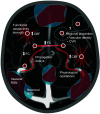Toward an integrative neurovascular framework for studying brain networks
- PMID: 35434179
- PMCID: PMC8989057
- DOI: 10.1117/1.NPh.9.3.032211
Toward an integrative neurovascular framework for studying brain networks
Abstract
Brain functional connectivity based on the measure of blood oxygen level-dependent (BOLD) functional magnetic resonance imaging (fMRI) signals has become one of the most widely used measurements in human neuroimaging. However, the nature of the functional networks revealed by BOLD fMRI can be ambiguous, as highlighted by a recent series of experiments that have suggested that typical resting-state networks can be replicated from purely vascular or physiologically driven BOLD signals. After going through a brief review of the key concepts of brain network analysis, we explore how the vascular and neuronal systems interact to give rise to the brain functional networks measured with BOLD fMRI. This leads us to emphasize a view of the vascular network not only as a confounding element in fMRI but also as a functionally relevant system that is entangled with the neuronal network. To study the vascular and neuronal underpinnings of BOLD functional connectivity, we consider a combination of methodological avenues based on multiscale and multimodal optical imaging in mice, used in combination with computational models that allow the integration of vascular information to explain functional connectivity.
Keywords: BOLD fMRI; brain optical imaging; functional connectivity; neurovascular coupling; neurovascular networks; vasculo-neuronal interactions.
© 2022 The Authors.
Figures




